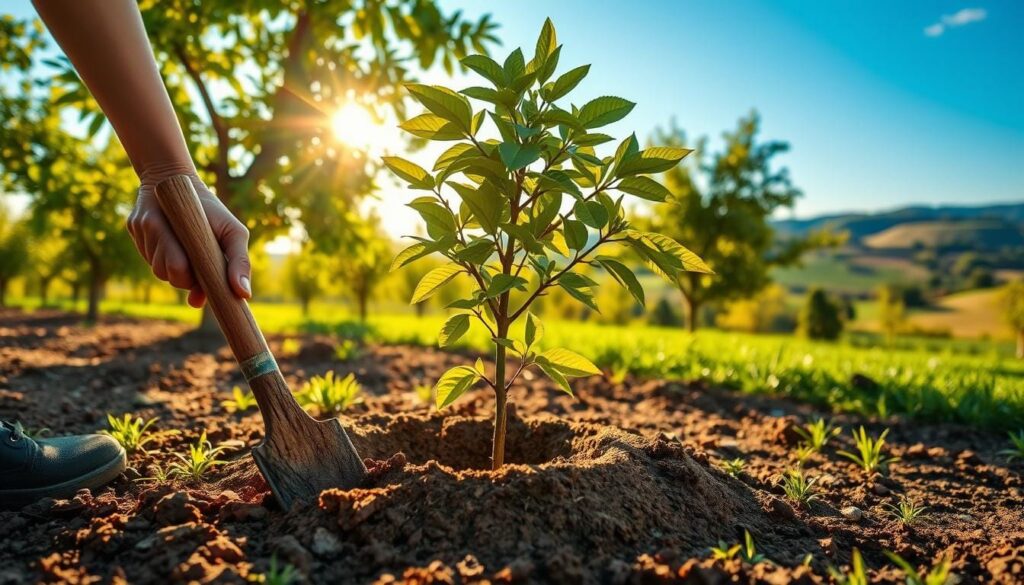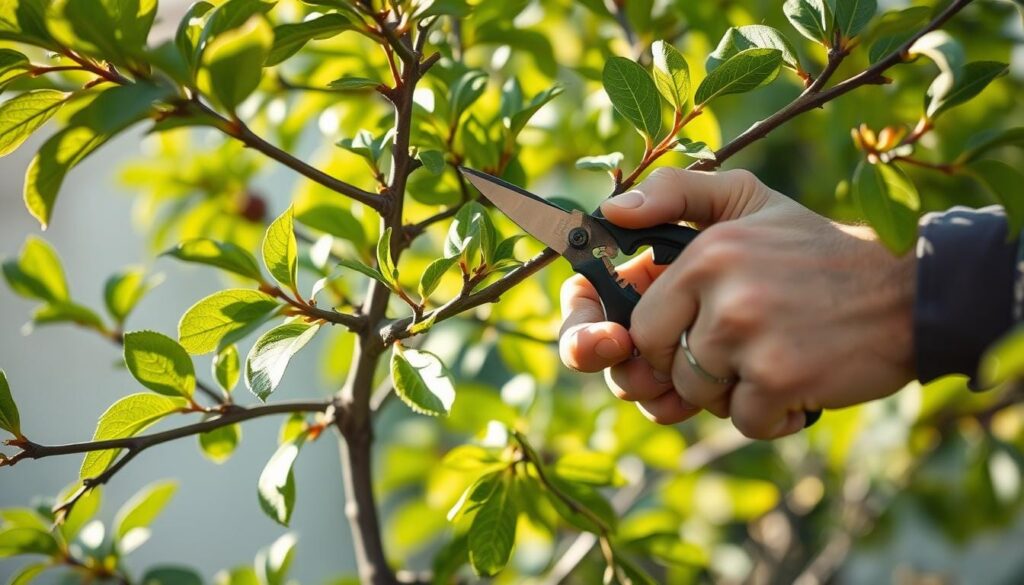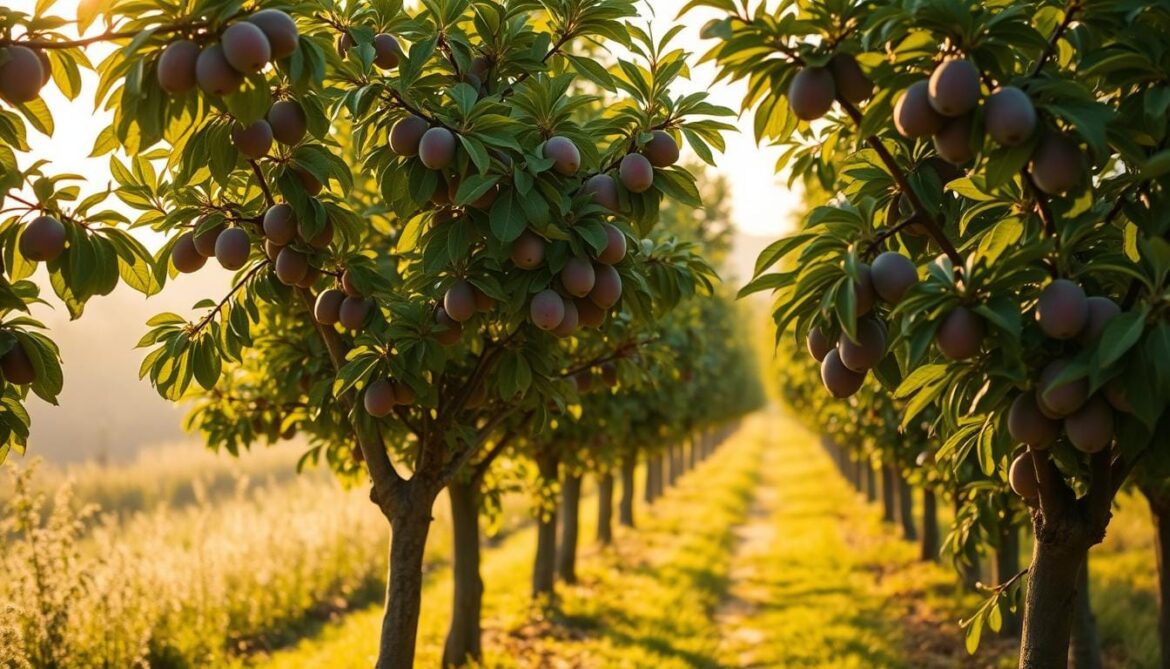Growing plum trees can be rewarding, but managing diseases is a big challenge. Imagine picking healthy, delicious plums in your backyard without worrying about diseases. Disease-resistant plum trees make this dream come true, giving gardeners a reliable way to grow fruit.
There are 15 types of plum trees perfect for home gardens. You can choose from European to Japanese varieties. These trees offer great fruit quality and are more resistant to common diseases.
Disease-resistant plum trees are a game-changer for gardeners. They are bred to fight off common tree diseases. This means healthier plants and more fruit for you.
Key Takeaways
- Disease-resistant plum trees reduce the need for chemical treatments
- Multiple varieties offer unique flavor profiles and disease tolerance
- These trees are suitable for various garden sizes and climates
- Lower maintenance requirements make them ideal for home gardeners
- Improved fruit quality and yield are significant advantages
Introduction to Disease-Resistant Plum Trees
Plum trees are a world of diversity, with over 100 species worldwide and about 30 in North America. Knowing about disease-resistant plum varieties is key for sustainable farming. It helps gardeners grow plums with little effort.
Native North American plum trees fight off many diseases well. They are a strong choice for gardeners wanting healthy, productive orchards without using lots of chemicals.
Defining Disease-Resistant Plum Trees
Disease-resistant plum trees are special types bred to face many challenges. They have genes that help them:
- Resist common fungal infections
- Tolerate harsh climate conditions
- Minimize susceptibility to pest damage
- Maintain robust growth patterns
Significance in Modern Gardening
In today’s gardening, disease-resistant plum trees are a smart choice. They help gardeners and orchardists grow plums in a way that’s good for the planet. By picking trees with natural defenses, they cut down on chemical use and support a healthier environment.
The U.S. grows over 1 billion pounds of plums every year. People eat between 0.9 to 1.9 pounds of plums each. Picking disease-resistant varieties means more fruit and less loss to pests and weather.
Benefits of Growing Disease-Resistant Plum Trees
Disease-resistant plum trees are a game-changer for gardeners and farmers. They help create high-yielding plum orchards with less chemical use. These trees bring many benefits that change how we grow fruit.
Growing organic plums is easier with these disease-resistant trees. They fight off common problems like plum pox virus (PPV) very well.
Reduced Chemical Treatment Requirements
Disease-resistant plum trees need less chemical treatment. They naturally fight off infections, which is great for several reasons:
- Less pesticide use
- Lower costs
- Greener farming
- Safer fruits
Enhanced Tree Health and Longevity
These trees are genetically improved for better health. Studies show they can grow and produce fruit for longer than regular plum trees.
| Characteristic | Disease-Resistant Trees | Traditional Trees |
|---|---|---|
| Average Lifespan | 25-30 years | 15-20 years |
| Annual Fruit Production | 150-200 lbs | 100-150 lbs |
| Pest Resistance | High | Low |
Superior Fruit Quality and Yield
Disease-resistant plum trees grow higher-quality fruits with better yields. They keep their fruit quality high, even in tough conditions. This makes them perfect for sustainable farming.
Experts say these trees can boost fruit production by up to 30%. This is a big step forward in farming technology.
Common Diseases Affecting Plum Trees
Plum trees face many diseases that can harm fruit production. This is true for both home gardeners and commercial growers. Knowing about these diseases helps keep trees healthy and prevents losses.
Plum trees are hit hard by several diseases. These diseases can hurt tree health and fruit quality. It’s key to spot and treat these diseases early for a successful orchard.
Brown Rot
Brown rot is a fungal disease that spreads through shriveled fruits. It thrives in humid weather and can destroy fruit crops fast. Infected fruits turn brown and soft, eventually becoming mummies.
- Spreads quickly in wet weather
- Causes fruit decay and early dropping
- Affects both green and ripe fruits
Plum Pox Virus
Plum pox virus is a big threat to plum trees. It spreads through aphids and grafting. There’s no cure for this virus.
| Transmission Method | Key Symptoms |
|---|---|
| Aphid transmission | Discolored rings on leaves and fruits |
| Grafting | Stunted fruit development |
Shot Hole Disease
Shot hole disease makes plum tree leaves look like they’ve been shot. It’s a fungal infection that lowers fruit yields and tree health.
- Creates quarter-inch purple round holes on leaves
- Leads to less fruit production
- Thrives in moist conditions
Commercial plum growers need to watch out for these diseases. They must manage them to keep their orchards healthy and fruit production steady.
Best Disease-Resistant Plum Tree Varieties
Choosing the right plum trees can make your garden thrive. There are many great options for gardeners looking for strong and fruitful trees. Selecting plum trees means picking ones that resist disease and taste great.
Methley Plum: A Resilient Performer
The Methley plum is a top pick for disease resistance. These trees grow fast, between 15 and 20 inches a year, and need little pruning. Gardeners love its ability to adapt and produce lots of fruit. It’s known for:
- Excellent disease tolerance
- Sweet, juicy purple-red fruits
- Thrives in multiple climate zones
Santa Rosa Plum: Exceptional Yield
Santa Rosa plum trees are another great choice. They can grow up to 25 feet tall and produce a lot of fruit. They’re also resistant to many plum diseases, making them perfect for big orchards.
| Characteristic | Santa Rosa Plum Details |
|---|---|
| Height | Up to 25 feet |
| Fruit Color | Purple-red |
| Disease Resistance | High |
Shiro Plum: Compact and Productive
Shiro plum trees are a great choice for smaller spaces. They grow between 18 to 20 feet tall and love full sun. Their light yellow fruits are sweet and perfect for eating fresh.
“Choosing the right plum variety can make all the difference in your home orchard’s success.” – Fruit Tree Experts
Each variety has its own benefits for your garden. They promise lots of fruit with little disease trouble.
Growing Conditions for Disease-Resistant Plum Trees
To grow disease-resistant plum trees well, you need to know the best conditions. These trees can do well in many places with the right care.
For organic plum farming, you must think about several important factors. These factors affect the health of the trees and the quality of the fruit.
Essential Soil Requirements
Plum trees need certain soil to grow strong and fight off diseases. The best soil is:
- Soil pH between 6.0 and 6.5
- Well-drained, loamy soil composition
- Rich organic matter content
- Good air circulation around root zones
Sunlight and Temperature Needs
Disease-resistant plum trees do best in specific conditions. Most need:
- Full sun exposure (6-8 hours of direct sunlight daily)
- USDA hardiness zones 5-8
- Consistent temperatures between 40-85°F
- Adequate winter chill hours (700-1000 hours)
Tip: Choose plum tree varieties that fit your local climate for the best results in sustainable plum farming.
How to Plant Disease-Resistant Plum Trees
Planting disease-resistant plum trees needs careful planning and the right techniques. These trees are great for gardeners who want to grow healthy fruit trees with little work. By following the right steps, your plum trees will grow strong and flourish in your garden.

Step-by-Step Planting Guide
Here are the key steps to plant disease-resistant plum trees:
- Choose a sunny spot with soil that drains well
- Make sure the soil pH is between 5.5-6.5 for best growth
- Dig a hole that’s twice as wide as the root ball
- Put the tree in the hole at the same depth as before
- Fill with native soil, but don’t put fertilizer on the roots
Tips for Successful Transplanting
Transplanting plum trees needs extra care. Choose the right time – late autumn to late winter is best for bare-root trees. Water them well, giving about 1 inch of water each week. Mulching keeps the soil moist and the temperature right.
Plant plum trees 12-18 feet apart for good air flow and less disease. They need extra care in their first year to grow strong roots and stay healthy.
Care and Maintenance of Disease-Resistant Plums
Starting a sustainable plum farm means knowing how to care for low-maintenance plum varieties. Taking good care of the trees leads to healthy growth and plenty of fruit. This makes growing plums a fun and easy task for gardeners.
Watering Practices for Optimal Tree Health
Plum trees need the right amount of water to grow well. Here are some important tips for watering:
- Give them 1-2 inches of water each week when they’re growing
- Water deeply to help the roots grow strong
- Make sure water drains well to avoid too much water
- Water less during the winter when they’re not growing
Mulching and Fertilization Strategies
Using good mulching and fertilizing can really help your plum trees stay healthy.
| Fertilization Stage | Amount | Timing |
|---|---|---|
| Newly Planted Trees | 1 lb 10-10-10 fertilizer | End of March |
| Second-Year Trees | 2 lb 10-10-10 fertilizer | March |
| Calcium Nitrate Application | 1.25 lb | July |
Pro tip: Keep a 4-6 foot circle around the tree weed-free. This helps the tree absorb nutrients better and grow stronger.
Low-maintenance plum varieties need a little care but it’s worth it. By following these tips, gardeners can grow healthy, fruitful plum trees with less work and more success.
Pest Management Strategies
Keeping disease-resistant fruit trees healthy is key. Organic plum production needs a smart plan to fight pests without harming the orchard’s natural balance.
Natural Pest Control Methods
Integrated Pest Management (IPM) is a green way to protect plum trees. It includes:
- Attracting helpful insects like ladybugs and lacewings
- Using pheromone traps to track pests
- Planting companion plants
- Keeping trees and soil healthy
Targeted Pest Management Techniques
Gardeners can keep their plum trees safe by watching closely and acting quickly. The University of California suggests:
- Spotting pests early
- Timing treatments carefully
- Using fewer chemicals
- Keeping natural predators safe
Watch out for Plum Curculio, aphids, and scale insects. They can harm trees and fruit if not controlled. Early action keeps trees strong.
Recommended Pest-Resistant Varieties
Choose plum trees that naturally fight pests. Look for varieties that are tough and fit your area well. This helps grow plums organically and cuts down on pest control needs.
Pruning Techniques for Healthier Trees
Maintaining disease-resistant plum trees needs careful pruning. This keeps the trees healthy and boosts fruit production. Pruning helps prevent disease and encourages fruit growth.

Pruning these trees right is key. It’s about knowing when and how to prune. Most plum trees do well with pruning that lets in lots of sunlight and air.
When to Prune Plum Trees
The best time to prune plum trees depends on their age and where you live:
- Young trees (up to 3 years): Light pruning in spring
- Established trees (over 3 years): Prune from mid-June onwards
- Avoid pruning during wet seasons to prevent silver leaf disease
Essential Pruning Tools and Techniques
For good pruning, you’ll need a few tools:
- Sharp, clean pruning shears
- Loppers for thicker branches
- Pruning saw for larger limbs
- Disinfectant for tool sterilization
Important pruning steps include:
- Cut branches back by approximately one-third
- Create an open, goblet-shaped canopy
- Remove crossing or damaged branches
- Maintain 3-5 main scaffold limbs
Pruning plum trees is an art. It balances health, disease prevention, and fruit production. By following these tips, gardeners can grow strong, fruitful trees that produce delicious plums year after year.
Harvesting Plums: Timing and Techniques
Getting plums right is key for top plum orchards and growers. Knowing when and how to pick plums greatly affects fruit quality and tree health.
Plum trees give 2 to 3 bushels of fruit each year. They’re great for both home gardens and big orchards. The best time to pick plums is late summer to early fall, depending on the type.
Recognizing Ripeness
Checking if plums are ripe needs careful watching. Look for these signs:
- Soft, slightly yielding texture when gently squeezed
- Color change to deep, rich hues
- Sweet, fragrant aroma
- Background skin color shifting to yellow for European varieties
Proper Harvesting Methods
Picking plums right helps avoid damage to fruit and tree. Here’s how to do it:
- Gently grasp the plum
- Twist softly from the stem
- Avoid pulling or yanking
- Use shallow containers to prevent bruising
Pro tip for commercial plum growers: Japanese plum varieties are best harvested a few days before fully ripe, while European plums should be picked when they begin to soften.
Storing plums right is key to keeping them fresh. Store them at 31-32°F with 90-95% humidity. This way, plums can stay good for 2-4 weeks in the fridge, keeping their taste and nutrients.
Common Challenges in Growing Plum Trees
Growing disease-tolerant plum trees needs knowing the obstacles that can harm them. These trees are very resilient. But, to farm plums sustainably, you must watch the environment and diseases closely.
Plum trees have many challenges that can hurt their growth and fruit. Gardeners must watch out for problems that can affect even the strongest disease-resistant varieties.
Environmental Stress Factors
Environmental conditions are very important for plum tree health. Key challenges include:
- Soil moisture imbalances
- Temperature extremes
- Insufficient sunlight exposure
- Poor drainage conditions
Disease Resistance Limitations
Even disease-tolerant plum trees can face problems. Research shows that many factors can affect tree health:
| Challenge | Potential Impact | Occurrence Rate |
|---|---|---|
| Leaf Yellowing | Nutrient Deficiencies | 30% of trees |
| Root Issues | Overwatering/Poor Drainage | 20% of trees |
| Pest Infestations | Aphid Damage | 15-40% of trees |
Sustainable plum farming needs constant monitoring and smart actions to avoid problems. Gardeners should check their trees often and keep growing conditions perfect for tree health.
Knowing these limits helps farmers create better plans. This way, they can grow strong and fruitful plum trees in their gardens or orchards.
Resources for Plum Tree Cultivation
To grow disease resistant plum trees, you need to keep learning and have good sources of information. Gardeners aiming for organic plum production can find many resources. These offer expert advice and support from a community.
Essential Books and Guides
Here are some key books to learn about growing plum trees:
- The Fruit Gardener’s Bible by Lewis Hill – A detailed guide to growing fruit trees
- Growing Fruit Trees by Jean-Marie Lespinasse – Tips for managing a fruit tree orchard
- Organic Fruit Production by Judth Taggart – A guide focused on organic plum growing
Online Gardening Communities
Join online groups to learn from other gardeners about disease resistant plum trees:
- National Gardening Association Forum
- GardenWeb Fruit & Orchards Discussion Group
- Reddit r/Gardening Subreddit
- Pinterest Gardening Boards
These online platforms share important tips on keeping plum trees healthy. They also help with pest control and organic growing methods.
Conclusion: Why Choose Disease-Resistant Varieties
Disease-resistant fruit trees are a smart choice for gardeners. They help with sustainable plum farming. These trees naturally fight off common orchard problems. This means less use of chemicals and healthier trees that give lots of fruit.
Choosing disease-resistant plum varieties has many benefits. These trees are strong against diseases like brown rot and black knot. This is a big help for plum orchards. For example, the President variety needs less fungicide, making gardening better for the environment.
Sustainable plum farming is about more than just fighting disease. It’s about having a garden that’s easy to care for and gives lots of fruit. Disease-resistant trees need less help, use fewer chemicals, and grow better fruit. By picking these trees, gardeners are choosing a long-term solution that’s good for both plants and fruit.
Key Takeaways
When setting up your home orchard, focus on disease-resistant plum varieties. They offer natural protection, need less care, and grow better fruit. Your garden will be healthier, produce more, and be more eco-friendly.

